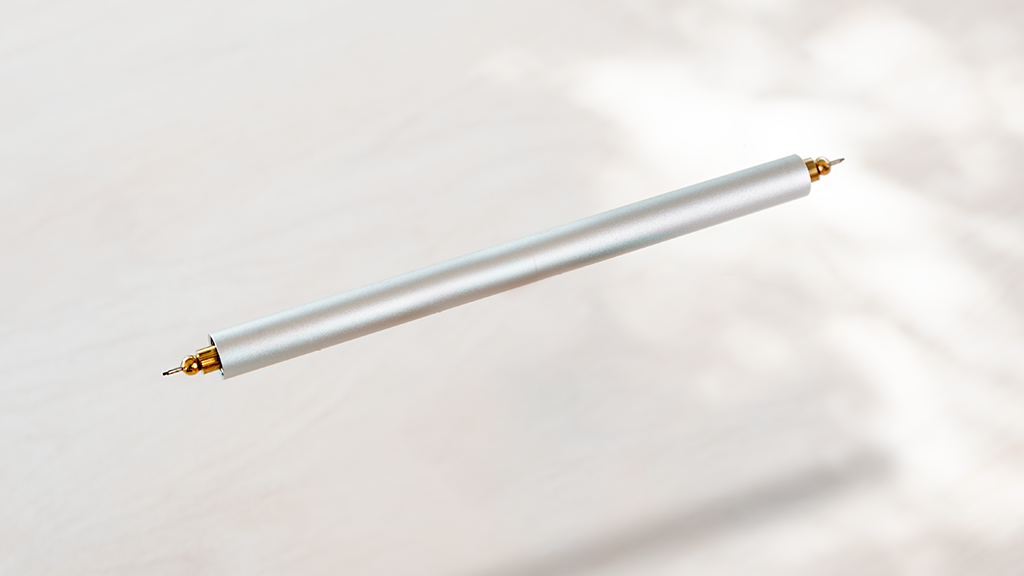The Lumos - How To
A brief guide to get you started with your new pen.

About the Lumos
The pen body of the Pro Single and the Lumos Write is the same, however the Pro comes with a full tip set whereas the Write comes with a writing tip only. All of our tips are compatible with all Lumos pens.
The Duo Lumos allows you to have two different pens in one body, allowing you to easily change between nibs and ink colours on either side.
The Single Lumos has one tip and one ink reservoir which is double the Duo's reservoir size.
I designed the Lumos due to a few things I found frustrating about other refillable fineliners. Firstly, there was still quite a lot of unnecessary waste; to refill the Copic requires you to buy a plastic disposable refill and a replacement nib for the Rotring costs £20+. You're also limited by the type of ink you can use in each pen and tied into their format (much like printer cartridges). I wanted to make an extremely high quality and versatile version of a refillable fineliner, and thus the Lumos was born.
No, the Lumos is made from anodised aluminium and PVD-coated stainless steel, both of which will not stain. It is also extremely hard wearing for everyday use.
I recommend regularly cleaning your pen in a bowl of warm soapy water to remove any residual ink. Make sure you thoroughly dry any components before reinserting them into the pen. Making sure there isn't any ink in the threaded parts of the pen. To lubricate your pen please use silicone grease, which creates a good seal between the components and will maintain the ink flow nicely.
All About Inks
- All nibs will work with all but the most experimental fountain pen inks (think shimmer + iridescent). I've tried a LOT and I'm yet to find one that doesn't work well. I'd encourage you to experiment and find the inks that work best for you!
- I recommend Sailor Kiwa-guro ink if you would like to use a waterproof archival pigment ink. 50ml will last you for years!
- Avoid using SketchINK with the fineliner tips as it can sometimes clog. It is fine to use in the brush, chisel and felt tips. We recommend our pigment fountain pen (link) if you require a waterproof ink for your fineliner tips.
- If in doubt, use ink designed for fountain pens or make sure that it's dye-based. Indian, acrylic and gouache-based inks will clog the pen. At least the tips and resevoirs are easily replaceable if this does happen!
There are two ways:
- You can flush out the nib and ink reservoir under a warm running tap. Dry all parts thoroughly and refill with another ink. There may be a small amount of the previous colour but it will quickly blend out.
- You can also replace the tip and reservoir as needed. Just take out the previous tip and reservoir and store them in a zip lock bag.
All about Tips
Nib sizes are different depending on the manufacturer (Eg Sakura, Staedler). If anything, ours are on the smaller side so it might be worth getting the size down from your preferred choice or buying the full tip collection to find the ones that work best for you here.
The tips are made by the best Japanese technical pen manufacturers, so they will outlive many of their peers. Dulling/flattening of the tip depends on a few factors:
- Smooth paper will decrease friction and in turn wear on the tips
- Point size of the nib, the smaller the tip, the more pressure is going through a smaller area, which can shorten the tip's life.
- A technique using excess pressure, or a style like a pointillism can shorten the lifetime of the tips.
- Ink used, some inks flow more freely, which decreases the friction.
The beauty is that you can replace these tips at a fraction of the cost and waste of other technical pens.
The Silcone part acts as a grip so that you can easily unscrew the plastic tip holder easily and without getting inky fingers.
TROUBLESHOOTING
Again, this all depends on Ink choice and where you store the pen. The beauty is that it's super easy to refresh the pen by recharging the reservoir with the original ink. If your pen is running a wee bit dry you can also dip the tip in water to get it going again.
Sometimes after a refill, if the ink reservoir isn't completely full the ink won't flow up to the tip properly. Try re-dipping & holding it in the ink reservoir for another 10 seconds (up to 20 seconds for a Duo reservoir). Make sure that the reservoir is secure when you place it back into the pen.
Any more questions?
